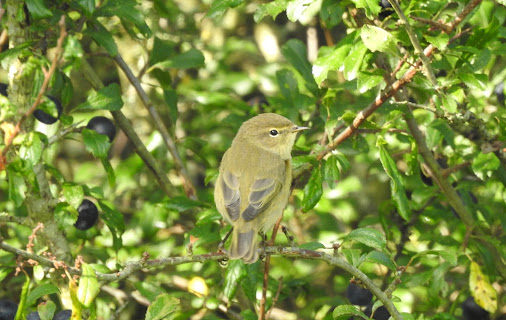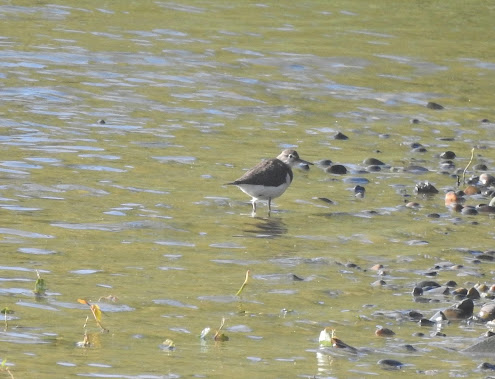It's that time of year again. Birds are winging their way southwards, and now it's possible to see them do it. Well it was today (Saturday), yesterday not so much. It's not that it wasn't happening yesterday, the breeze was a light westerly and the sun shone brightly. But therein lies the problem.
Sunny days are great for photographing stuff, but not so good for working out where in the sky that tiny bird that just went "tsip" is. So instead I wandered around, pointing my camera at anything near enough and counting the birds in the bushes.
 |
| Chiffchaff caught mid wing-quiver |
Chiffchaff's took centre stage, and I counted 14 of them as I wandered round the patch. The one shown above was quivering its wings in display to another Chiffchaff. By contrast I only saw one Blackcap and no other warblers.
Overnight rain has caused the water-level to rise, so there were no waders other than Snipe and Lapwing. On the plus side the route passed the Kingfisher Pool remains passable with care and even better, gave good views of a Kingfisher and a Grey Wagtail.
 |
| Kingfisher |
 |
| Grey Wagtail |
As for overhead migration, there was a steady trickle of Meadow Pipits and a substantial flock of hirundines, mainly Swallows with a few House Martins.
This morning the wind had swung round to a light southerly. I was due to join the ringers (Tony and John today) so this meant an earlier start, 08.00. I had decided to vizmig (visual migration) properly, which meant standing still for two hours and looking skywards.
The early start is one reason I don't do much vizmigging, and it really is a key factor. In the first hour I counted 157 Meadow Pipits and 95 Swallows heading south. The second hour saw Swallow numbers dip to 25 south, although Meadow Pipits were no less frequent.My tally after two hours was 312 Meadow Pipits, 120 Swallows, 18 Siskins, eight Lesser Redpolls, two Chaffinches, seven Alba (probably Pied) Wagtails, and a Grey Wagtail. There were also small parties of Skylarks, Linnets, and Goldfinches which may have been migrating, and I heard a Mistle Thrush, the first for ages.
The ringers were having a good morning too, but I was concentrating too much to be good company. That's another thing about vizmigging, when the birds are moving you have to be fully switched on. The camera is pretty much an irrelevance (well mine is anyway), with no chance of getting a recognisable image of anything because they are all too high up. However, some high cloud was extremely helpful because its a lot easier to count the dots against a whiteish background.
Nevertheless I did notice one bird of worth in the hedge behind me. A male Yellowhammer appeared and unlike with the one a few days ago it was not backlit.
 |
| Yellowhammer |
It didn't find its way into the nets either.
After two hours, normal birding activity was resumed. I headed towards the flash pools spotting three Stonechats on the way, and once there, saw pretty much the same birds as yesterday, counting 50 Teal, 27 Lapwings, five Snipe and three Shovelers.
I couldn't help noticing that Meadow Pipits were still moving, and I had an additional party of nine Lesser Redpolls going over. But the Swallow tap had been switched off and I added just two more.
As next month progresses there should be further opportunities for vizmigging, but the cast will gradually change to thrushes and their ilk. There probably won't be anything rare on offer, but the visual spectacle can, on a good day, more than make up for that.
PS: The ringing totals were:

































